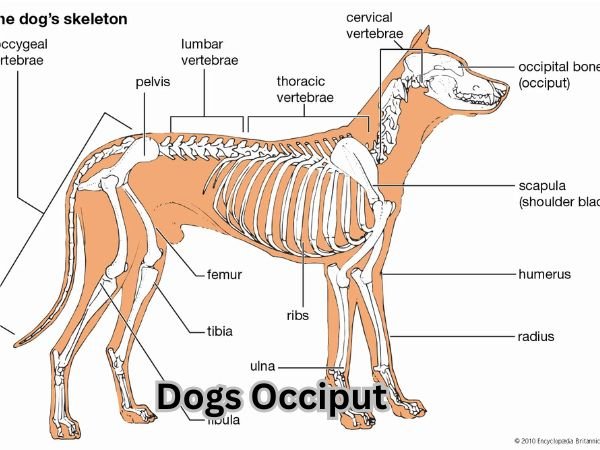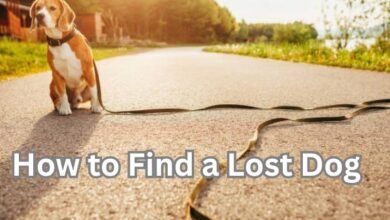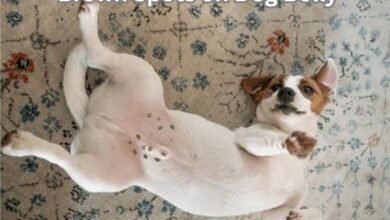
Have you ever noticed the curious “wisdom bump” or raised spot on the back of your dog’s head? This feature, known in dog head anatomy as the occiput, often sparks questions from pet owners. The dogs occiput is more than just a bump on your dog’s head—it’s a key part of their skull, providing protection for the brain and anchoring strong neck muscles. While its shape and prominence can vary widely—from barely noticeable to strikingly distinctive—across different breeds, this area is always central to your dog’s well-being.
Keeping an eye on changes to the occiput is crucial. Sometimes, what looks like an ordinary bump may be a warning sign of a health issue that needs urgent attention. In this article, we’ll reveal five alarming signs involving the occiput that every dog lover should watch for, helping you keep your best friend healthy and happy.
What Is the Occiput in Dogs?
Ever noticed a bump at the back of your dog’s skull? That bump is called the occiput. The occiput is the part at the rear of the skull where several bones meet. For dogs, it’s the highest point at the base of the skull, right where the head meets the neck.
The Role of the Occiput in Canine Anatomy
- Protection: The occiput helps protect the brain, especially the area that controls movement and balance.
- Muscle Attachment: Many important neck muscles attach at the occiput. These muscles let your dog move their head up, down, and side to side—super useful for sniffing and looking around.
- Body Language: In some dogs, you can see the occiput more clearly when they are excited, alert, or concentrating.
Breeds With a Prominent Occiput
While all dogs have an occiput, in some breeds the bump is more obvious. That’s totally normal and can be a charming breed trait!
You’re likely to notice a larger or more pronounced occipital bump on:
- Labrador Retrievers
- Golden Retrievers
- Bloodhounds
- Cocker Spaniels
- Setters
For some of these breeds (like Bloodhounds), the prominent occiput helps make their head shape more “classic,” but it doesn’t mean much about their abilities.
Occiput Size: Debunking a Common Myth
You might hear people say, “A bigger occipital bump means a smarter dog” or “Dogs with a big bump have a better sense of smell.” This isn’t true.
- The occiput’s size does not affect your dog’s intelligence or nose power.
- The bump is just part of their natural skull shape.
- Intelligence and sense of smell come from the brain—what’s inside, not bumps on the outside!
Takeaways for Dog Owners
- Touching your dog’s occiput is normal—many dogs like head rubs there!
- If you notice any sudden swelling, pain, or change in your dog’s occiput, contact your vet to rule out injury or health issues.
- Remember, a pronounced occiput is just a feature, not a sign of anything unusual or “special powers.”
The occiput is just one little piece of your dog’s unique appearance. It adds character, but how smart or talented your dog is depends on so much more—like love, play, and lots of positive training!
Why Should You Monitor Your Dog’s Occiput?
You might have noticed a bump on the back of your dog’s head. That’s the occiput—a natural part of your dog’s skull. While it might seem like just a bony lump, the occiput plays an important role in your dog’s overall health and well-being.
What Does the Occiput Do?
The occiput isn’t just there for looks. It has two main jobs:
- Protection: The occiput forms part of the skull, acting as a shield for your dog’s brain from bumps, knocks, and rough play.
- Muscle Attachment: It’s a major attachment site for muscles, especially those controlling head and neck movement. When your dog looks up at you or shakes off water after a bath, the muscles connected to the occiput are hard at work!
Why Monitor Your Dog’s Occiput?
Keeping an eye on the occiput can help you spot early signs of health issues. Here’s what to look for:
- Unusual swelling or changes: If the occiput looks larger, feels soft, or has changed shape, it may signal a problem.
- Pain when touched: If your dog flinches or seems sensitive when you touch this area, don’t ignore it.
Potential Health Issues Linked to the Occiput
Issues with the occiput sometimes point to bigger health problems, such as:
- Bone Disease: Conditions like tumors, bone infections, or genetic disorders can cause changes in the occiput.
- Trauma: A fall or a knock to the head may injure the occipital bone, leading to swelling or pain.
- Infections: In rare cases, infections can reach the skull and show up as swelling or tenderness at the occiput.
How to Keep Your Dog’s Occiput Healthy
- Gently check your dog’s head during grooming or petting.
- If you notice anything unusual, write down when you found it and any changes in your dog’s behavior.
- Contact your vet if you see swelling, lumps, or if your dog acts like the area is sore.
Building a Strong Bond
Spending extra time checking and caring for your dog’s occiput is a chance for bonding and reassurance. Your gentle touch and attention help your dog feel safe and loved—and ensure they stay happy and healthy for years to come.
In short: The occiput may be small, but it protects your dog in big ways! Give it a little attention during your regular pet checks and you’ll be doing something wonderful for your four-legged friend.
5 Alarming Signs of Occiput Issues in Dogs
The occiput is that bony bump on the back of your dog’s head. While some breeds have a more pronounced occiput (think Labradors and Bloodhounds), changes in this area can sometimes signal a problem. As a pet owner, knowing what’s normal and when to worry can help you keep your dog happy and healthy.
1. Sudden or Unusual Swelling
Occiput swelling in dogs can be due to normal breed differences—some dogs just have a bigger bony bump. But if you notice a sudden, soft, or rapidly growing lump that wasn’t there before, it’s time to pay attention.
- Normal: A firm, bony ridge that’s always been part of your dog’s skull shape.
- Concerning: Swelling that appears out of nowhere, feels soft, or causes your dog discomfort. This could signal trauma (from a bump or fall), infections, abscesses, or even a tumor.
- Action Tip: If you suspect abnormal swelling, check for other signs like pain or changes in behavior and call your vet for advice.
2. Pain or Sensitivity When Touched
Dogs can’t tell us when something hurts, but they show us in other ways. Watch for these signs if you touch or gently press the back of your dog’s head:
- Yelping, whining, or growling
- Pulling away or acting suddenly afraid
- Becoming aggressive, even if they’re usually friendly
Your dog may also avoid activities that involve head movement, like playing or looking up, or seem stiff around the neck.
3. Redness, Warmth, or Discharge
Red, hot, or oozing skin over the occiput is not normal. These signs can mean an infection or a head injury.
- Dog head injury symptoms: Redness, swelling, or any discharge (pus or blood) are red flags.
- Action Tip: Don’t wait—see your vet right away. Infections in this area can progress quickly and may need antibiotics or other treatment.
4. Change in Head Posture or Movement
Have you noticed your dog suddenly holding their head at an odd angle, struggling to turn it, or losing their balance?
- Stiffness or difficulty moving the head can indicate pain, joint issues, or even nerve problems.
- Head tilting or wobbling when walking could mean trouble deeper inside the skull, involving the nervous system or bones.
5. Additional Systemic Symptoms
If your dog is not acting like themselves along with head swelling or pain, it’s time to get concerned:
- Lethargy, loss of appetite, or behavior changes
- Head scratching (sometimes called “phantom scratching”)
- Signs of serious conditions like caudal occipital malformation, a syndrome where skull shape puts pressure on the brain
Any of these symptoms mean your dog needs to see a veterinarian as soon as possible.
Trust your instincts: you know your dog best. If you see any of these warning signs, especially a combination of them, don’t wait to get professional advice. Quick action can make all the difference in keeping your furry friend comfortable and safe!
Dogs’ Occiput: What To Do If You Notice Changes
The occiput is the little bump at the back of your dog’s head. It’s completely normal, but sometimes owners notice changes—like swelling or new bumps—and wonder what to do next. Let’s walk through simple steps to keep your dog healthy and ease your worries.
Home Monitoring Checklist
Check your dog’s occiput once a week. Make this a gentle part of your regular petting routine—your dog will love the attention!
- Look for any swelling, bumps, or changes in shape.
- Gently touch the area for signs of soreness or sensitivity. Notice if your dog pulls away or looks uncomfortable.
- Watch for redness, hair loss, heat, or new lumps.
- Note any changes in your dog’s behavior, like head shaking, scratching, or acting tired.
Keep a Record
If you find something unusual, don’t panic. Write down what you see and feel:
- Date you noticed the change.
- Size, color, or shape of any lump or swelling.
- Whether your dog seems bothered by it.
- Take clear photos if possible—these can be a big help for your vet.
When to Call the Vet
Contact your vet if:
- The lump or swelling lasts more than a week.
- You notice rapid growth or it gets worse.
- Your dog is in pain or acting very differently.
- There’s an open sore, bleeding, or signs of infection.
What to Expect at the Vet
Your vet will start with a hands-on examination and may:
- Ask questions about when you noticed the changes and if there are other symptoms.
- Run diagnostic tests, like bloodwork or a fine-needle aspiration (a simple way to check what’s inside a lump).
- Suggest imaging, such as X-rays or ultrasound, to get a closer look.
- Talk you through treatment options, which can include medication, draining the lump, or removing it if needed.
Most occiput changes are harmless, but it’s always best to have a professional check. Quick action and steady monitoring help keep your furry friend happy and healthy!
Caring for Your Dog’s Occiput: Prevention and Safety Tips
The occiput—the bump at the back of your dog’s head—might seem mysterious, but it plays an important role in skull structure and muscle attachment. Keeping this area healthy, especially when enjoying the great outdoors, helps protect your furry friend from injury.
Why Is Occiput Care Important?
Injuries to the occiput are rare but can happen during outdoor activities, rough play, or accidental bumps. Dogs with pronounced occiputs (like Bloodhounds or Dobermans) may be a bit more prone to knocks. Most importantly, the occiput’s health can also signal overall well-being—sudden changes in its size or shape should be discussed with your vet.
How to Prevent Occiput Injuries
1. Practice Safe Hiking With Dogs
- Leash Up: Always keep your dog on a leash unless in a fully enclosed or designated off-leash area. Leashes prevent risky wildlife encounters and wandering into dangerous terrain, like steep cliffs or thick underbrush.
- Choose Dog-Friendly Trails: Stick to trails that allow dogs and avoid areas with sharp rocks, dense brush, or risky drop-offs.
- Mind the Weather: Hike during cooler times and bring enough water to prevent dehydration and overheating. Dogs can overheat quickly, and heatstroke can affect their whole body, including the head.
- Watch for Fatigue: If your dog pants heavily, lags behind, or seems reluctant to go on, take a break. Start with shorter walks if your pup is new to hiking.
- Protect the Paws: Use dog booties on rough terrain to shield paws and to give a little extra slip resistance, reducing falls and head bumps.
2. Outdoor Dog Safety at Home
- Supervise Play: Always watch dogs during outdoor play, especially around obstacles like garden furniture, fences, or rocky landscaping. Even at home, accidents happen.
- Provide Soft Areas: Offer cushioned spots for rest outdoors, just like you would inside. Memory foam or padded beds can help prevent bumps.
- Check Fencing: Ensure your yard or outdoor space doesn’t have gaps, loose boards, or sharp edges that could catch or bruise your dog’s head.
3. Use Dog Head Protection if Needed
- Consider Helmets: For working dogs, senior dogs, those prone to falls, or dogs with neurological issues, a padded dog helmet or head protector may be helpful. Options range from lightweight foam to sturdy plastics and custom-fit headgear.
- Proper Fit Matters: Any protective helmet should be snug but comfortable, allowing your dog to move naturally and see clearly.
4. After Outdoor Adventures
- Check for Injuries: After hikes or play, give your dog a thorough once-over. Look for bumps, bruises, or signs of discomfort around the head. Watch for redness or swelling, which could signal an injury.
- Groom and Inspect: Brush your dog to check for ticks, plant burrs, or anything stuck in their fur, especially around the bump at the back of their head.
Actionable At-Home Care Tips
- Massage your dog’s occiput gently after energetic play—just use your thumbs in slow circles, applying light “petting a butterfly” pressure for 3–5 minutes. This can help relieve tension, especially after fetch or long days.
- If you notice sudden changes in the occiput’s size, increased tenderness, or any unusual symptoms (like pain, swelling, or loss of appetite), contact your veterinarian for assessment.
Caring for your dog’s occiput is about more than preventing injury—it’s about making sure adventurous days are worry-free. With these easy tips, you’ll keep your best friend safe and happy on the trail or in your backyard, building memories to last a lifetime.
Conclusion: Prioritizing Your Dog’s Skull Health
Your dog’s occiput might be a small part of their body, but it’s important. Regular checks and paying attention to how your dog moves and feels can help catch problems early. Don’t hesitate to reach out to your vet if you notice any occiput-related changes. Your dog’s health, comfort, and happiness are worth it!
FAQ
What is a dog’s occiput?
A dog’s occiput is the bony bump on the back of the head. It protects the skull and is where some neck muscles attach. It’s more visible in some breeds.
Why is my dog’s occiput swollen?
Swelling in the occiput could mean injury, infection, a bug bite, or even a tumor. If it looks unusual or your dog acts different, see your vet.
Should I worry if my dog’s head bump gets bigger?
Yes, if the bump grows or feels soft, it could be a cyst, abscess, or something more serious. A vet check is the safest step.
Is it normal for dogs to have a lump on their head?
Yes, many dogs naturally have a firm bump called the occiput. But new or changing lumps should be looked at by a vet to rule out problems.
Can a dog’s occiput be painful?
It can be if there’s an injury, swelling, or infection. If your dog avoids touch, whines, or acts upset, the bump may hurt and needs vet care.



